Kimbap (Korean Seaweed Rice Rolls)
Make classic Korean kimbap (gimbap) at home with colorful veggies, seasoned rice, and your choice of protein—all wrapped in roasted seaweed. It’s a great meal on the go finger food . This step-by-step recipe includes a unique twist with Korean plum extract for extra brightness and flavor.
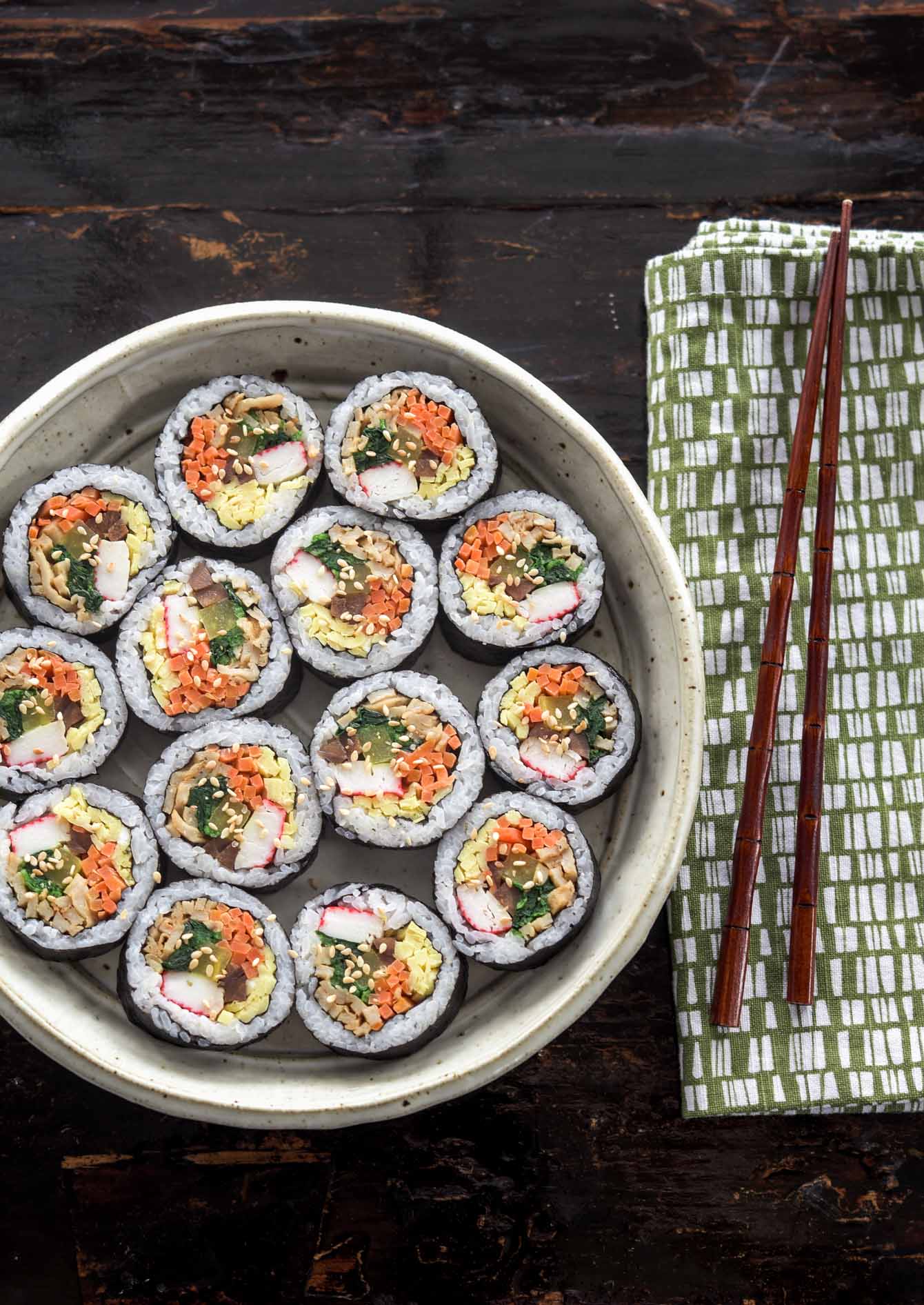
When I was little, my mom would pack kimbap for every school picnic. The rolls were never fancy, but her secret seasoning—a splash of homemade plum extract instead of sesame oil—gave the rice a bright, tangy sweetness that made her kimbap extra special.
I still remember the year her kimbap won first prize at our school picnic, and that little trick has never left my kitchen. To this day, it’s the reason my family adores her recipe.
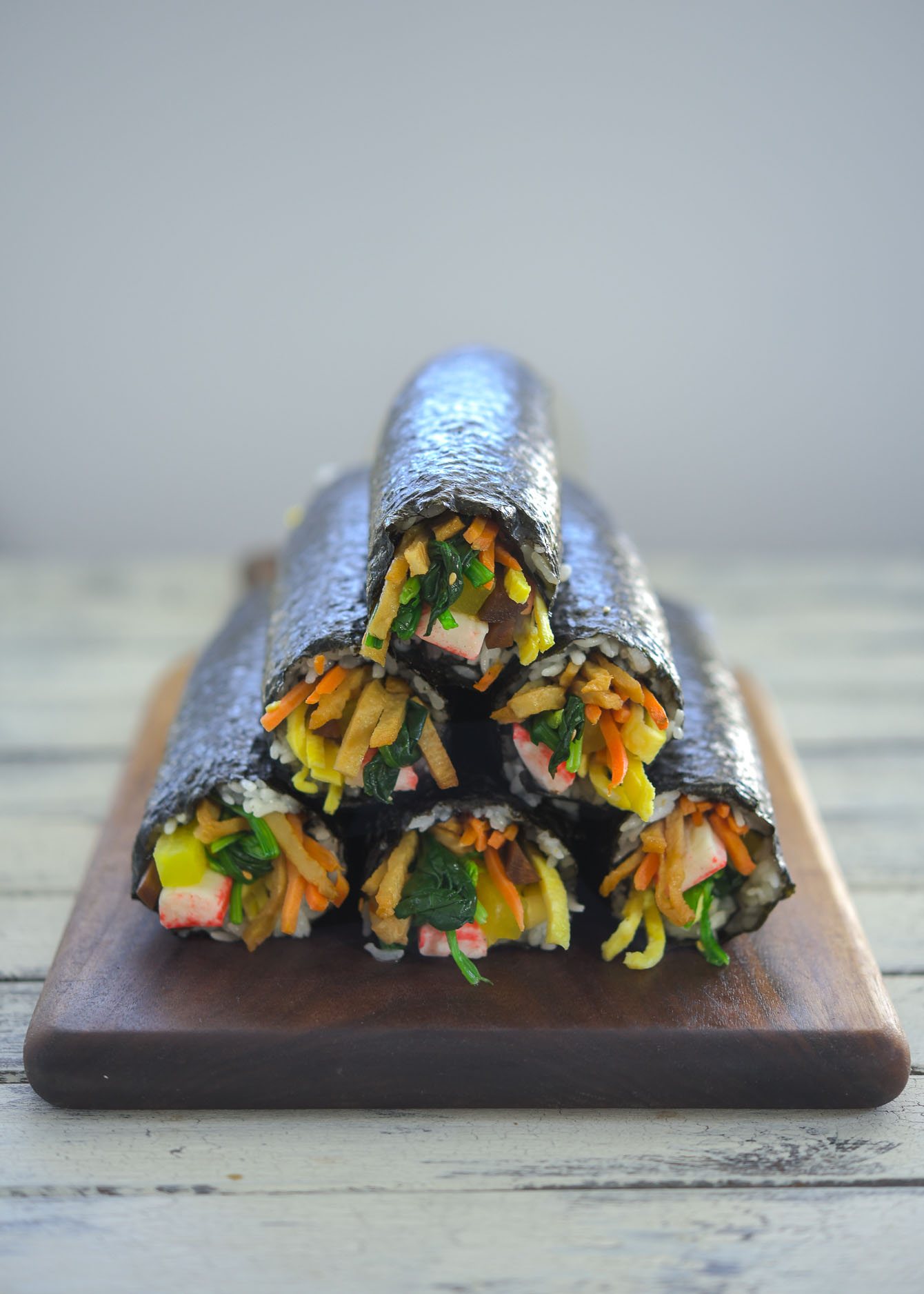
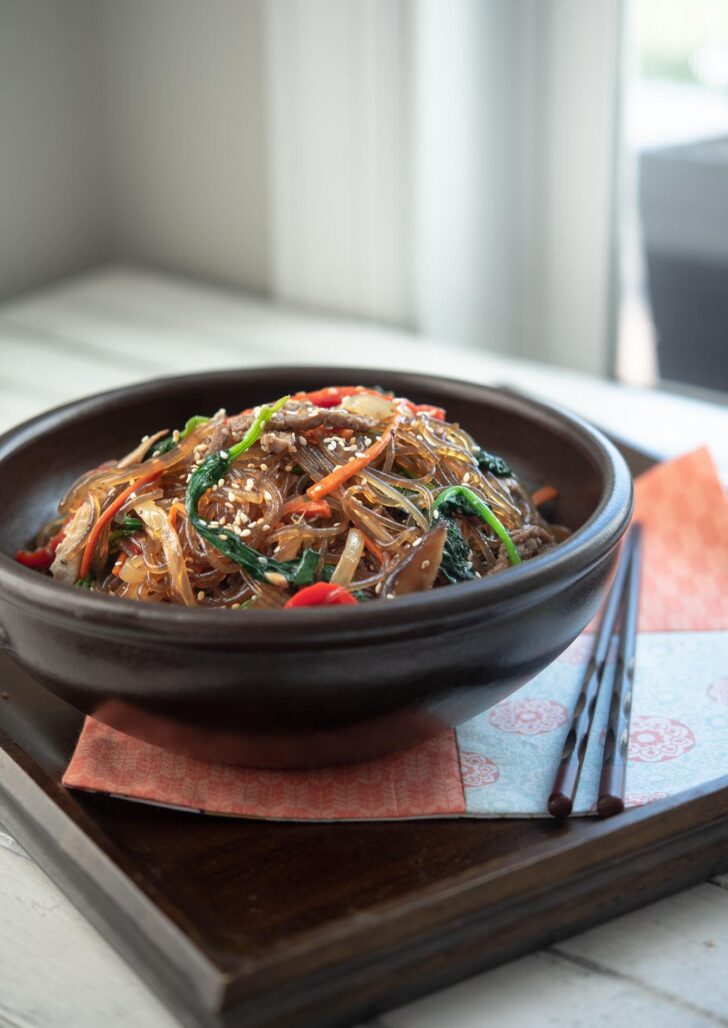
Get new recipes via email:
That’s the beauty of kimbap. Beyond the colorful layers of egg, carrots, spinach, and pickled radish, every family has its own way of making it — a favorite filling here, a seasoning tweak there.
Some people refer to kimbap as Korean sushi rolls, but it’s truly its own dish. While sushi focuses on raw fish and vinegar-seasoned rice, kimbap is built on sesame- or plum extract–seasoned rice with a wide variety of cooked and pickled fillings.
Once you taste it fresh, warm, and cut straight from the bamboo mat, you’ll see why homemade kimbap is unmatched , no store-bought roll can compare.
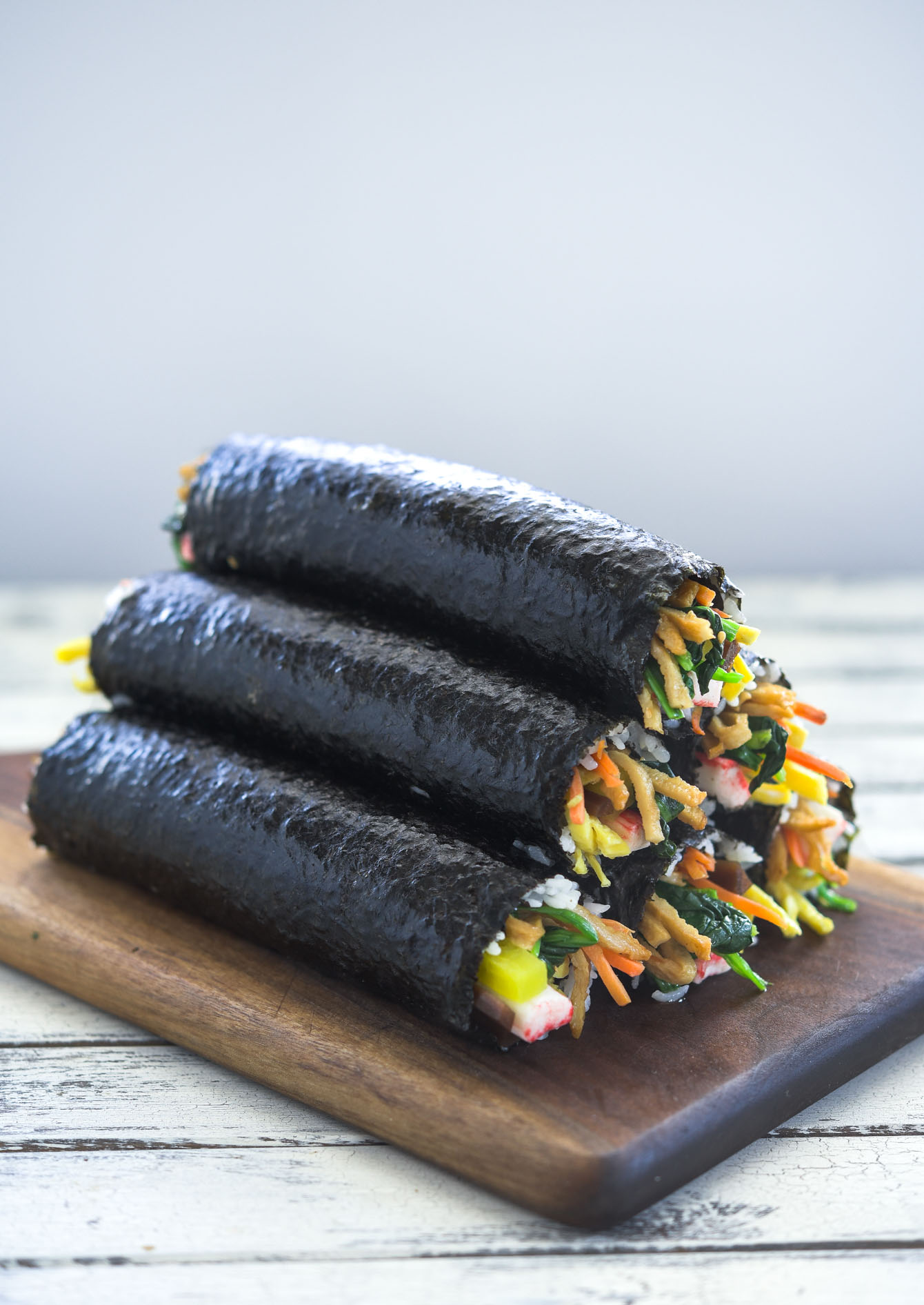
What Goes Into Kimbap: My Ingredient Notes
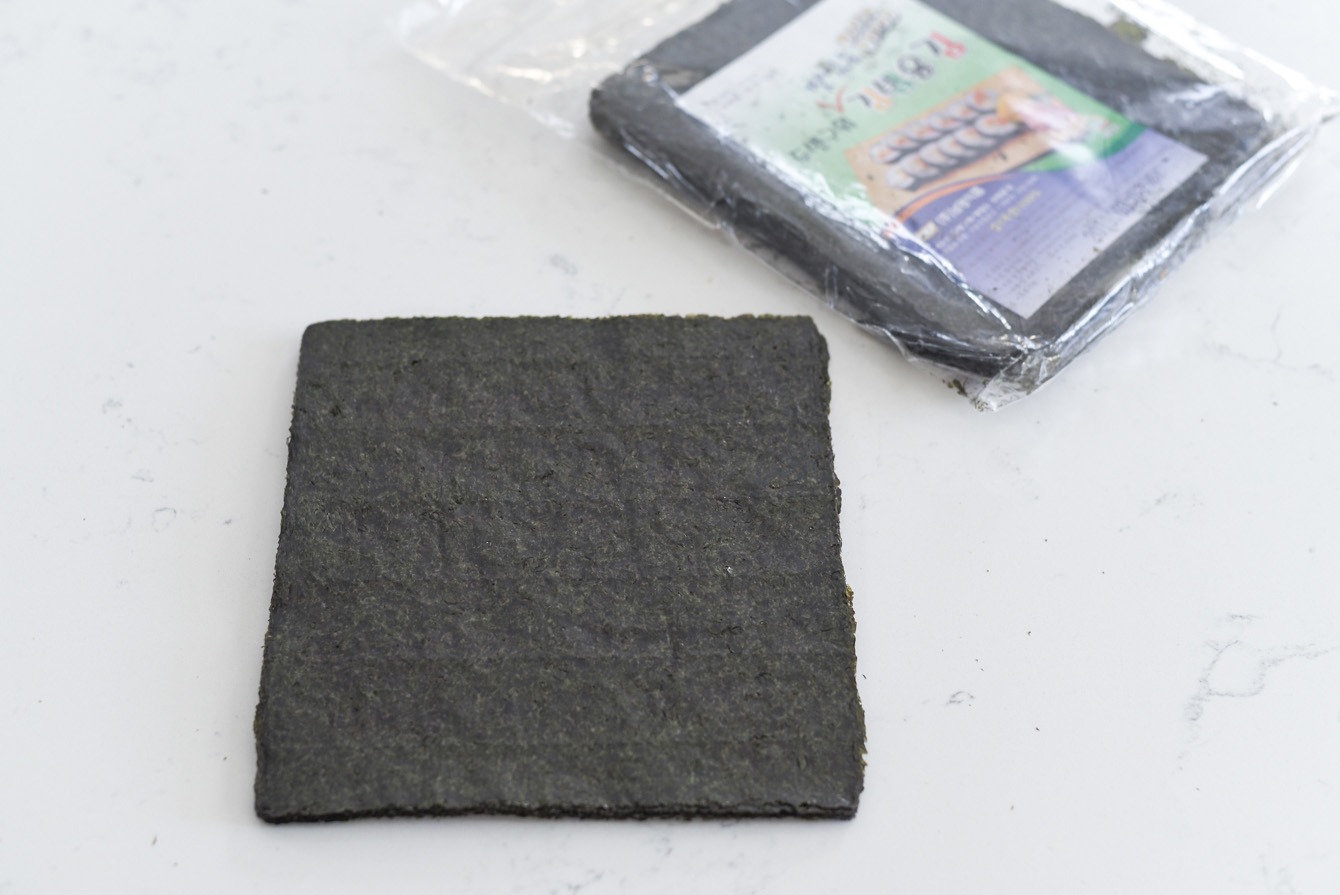
Dried Seaweed Sheets (Gim):
In Korea, we use roasted gim for kimbap — the kind that’s deep green and smells toasty when you open the pack. If the sheets look dull or have red spots, they’re old and won’t roll cleanly. I always buy extra and keep them in the freezer; it keeps the sheets crisp and prevents that stale taste.
Seasoned Rice:
The rice is the backbone of kimbap. Always use freshly cooked short-grain white rice so it clings together when rolled. Instead of the typical sesame oil, I season mine with Korean plum extract (maesil-cheong). It adds a light sweetness and subtle tang.
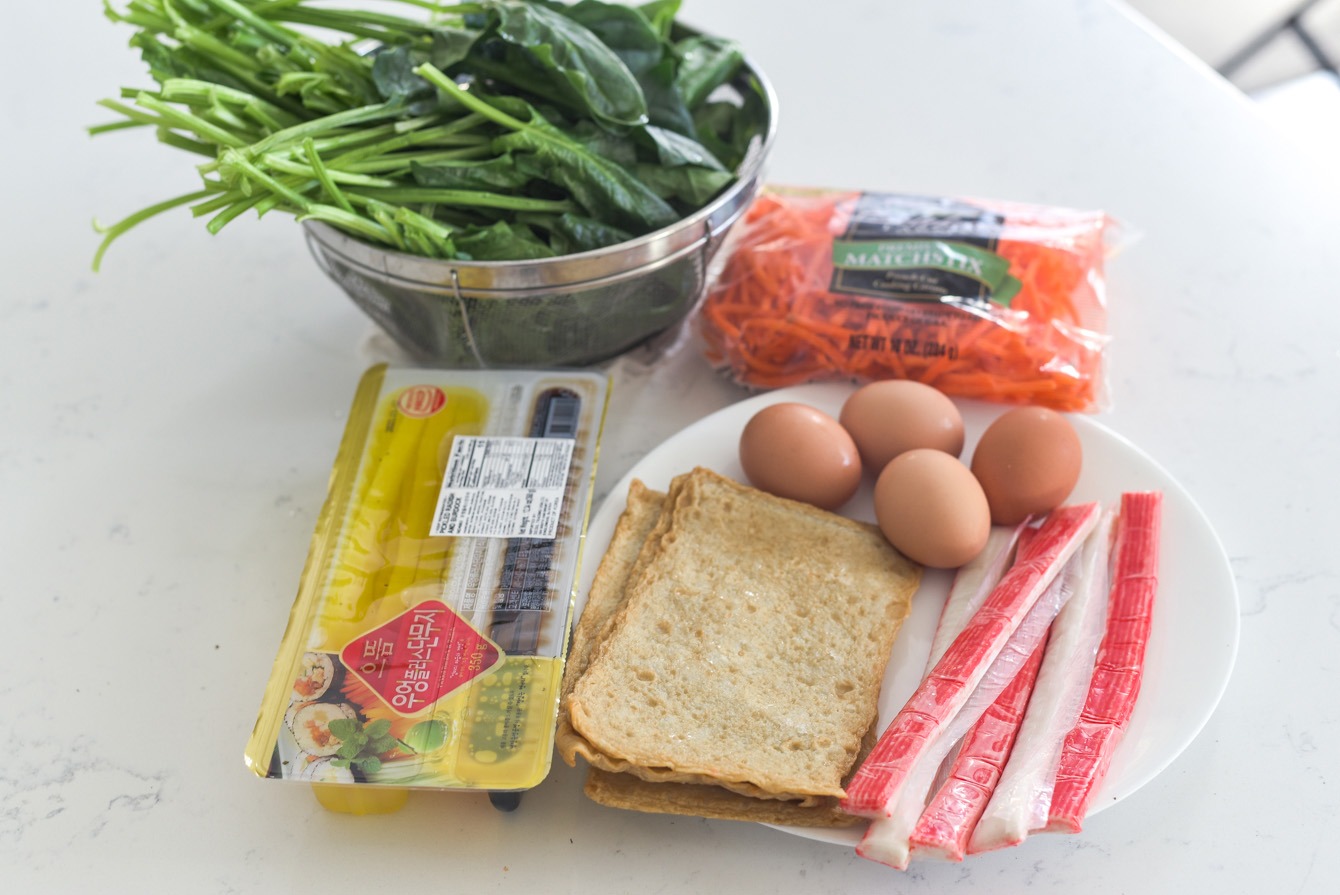
Vegetable Fillings
Carrots, spinach, and pickled radish (danmuji) are my non-negotiables. Carrots give crunch, spinach softens the bite, and danmuji adds that signature sweet-tangy pop. Without the yellow daikon, it just doesn’t taste like kimbap. Sometimes I’ll also add braised burdock root (oeong) for a touch of earthiness.
Protein Options
Classic kimbap usually includes thin egg strips, crab sticks, or stir-fried fish cake. My favorite upgrade is grilled pork bulgogi — the smoky, sweet meat turns a humble roll into a meal. If you are a fan of tuna, check out my tuna kimbap with cucumber for anther easy recipe.
Other popular choice would be a bit of seasoned squid (ojingeochae muchim) or stir-fried anchovies (myulchi bokkeum) tucked in the rice rolls. Those little touches remind me of the lunchbox rolls my mom made when I was growing up.
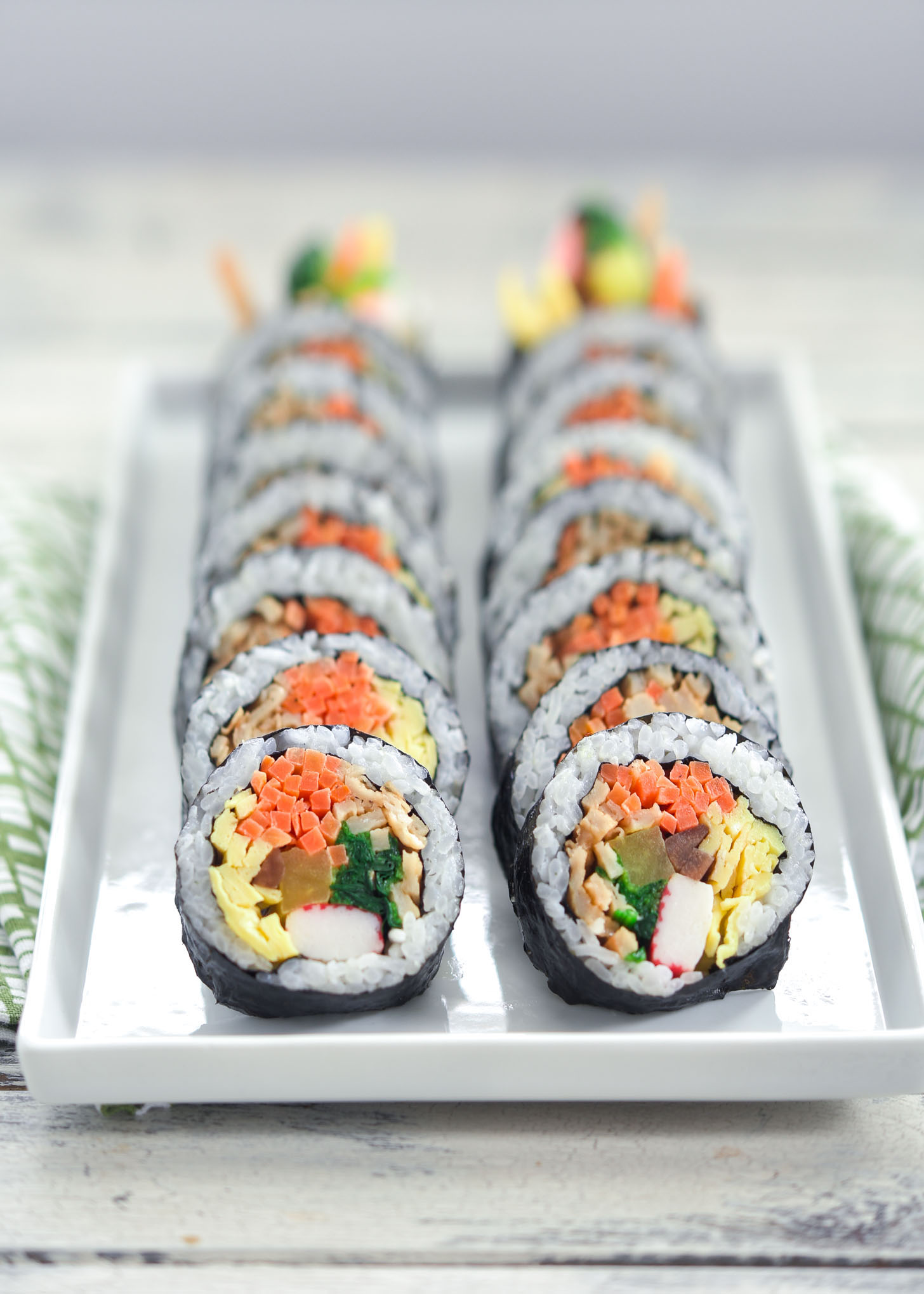
Step-by-Step: How to Make Kimbap
Rolling kimbap isn’t difficult once you see it in action. Here’s my process, with photos and tips that make the difference between a loose roll and a neat, tightly packed one. Think of this as a visual guide — you’ll find the exact measurements and cooking times in the recipe card below.
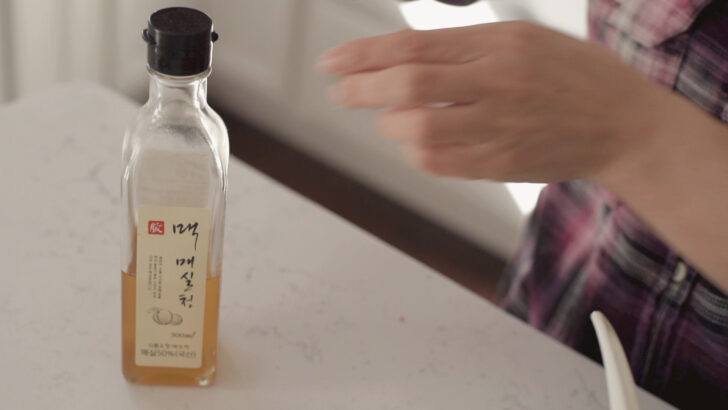
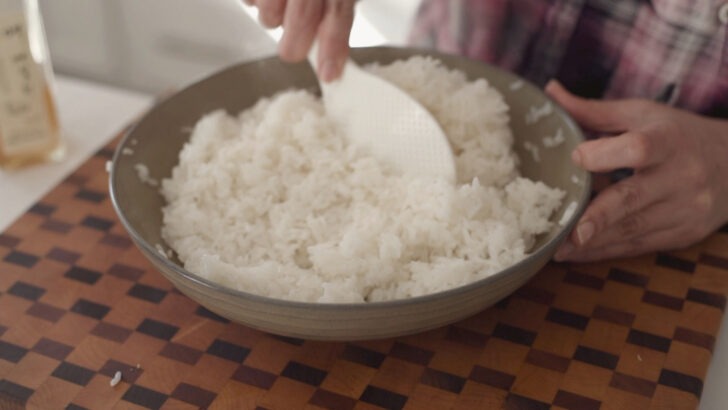
Rice first: Rice is the backbone of kimbap. If it’s too hot, the seaweed softens and tears; if it’s too cold, it won’t stick. I let it cool just until warm, then season with plum extract (instead of the usual sesame oil) and salt.
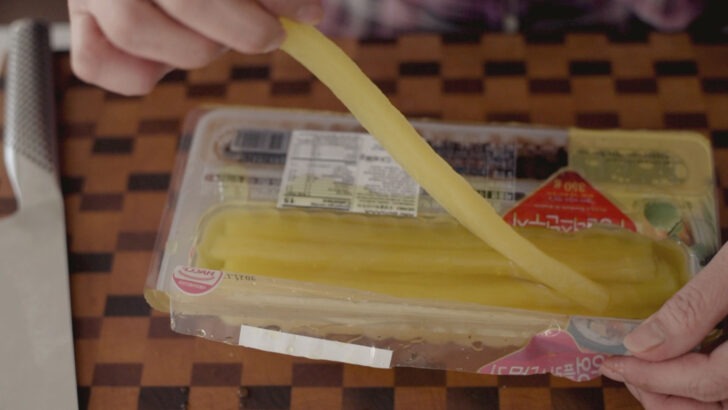
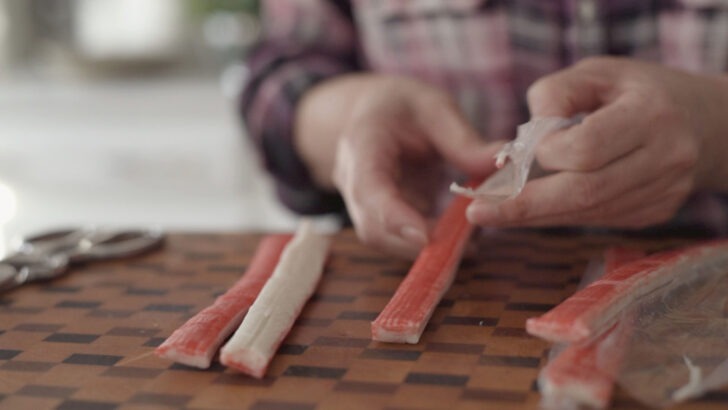
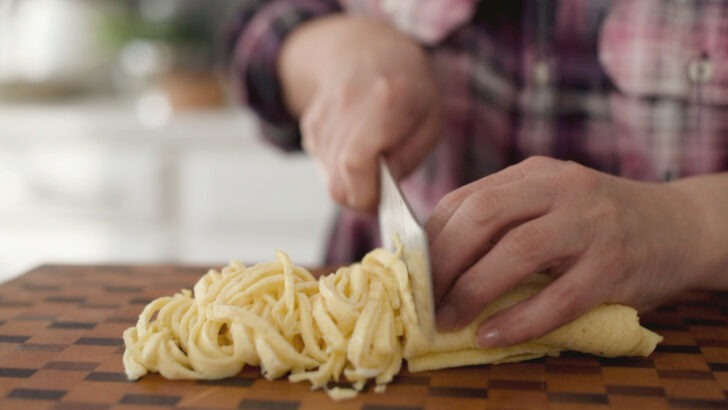

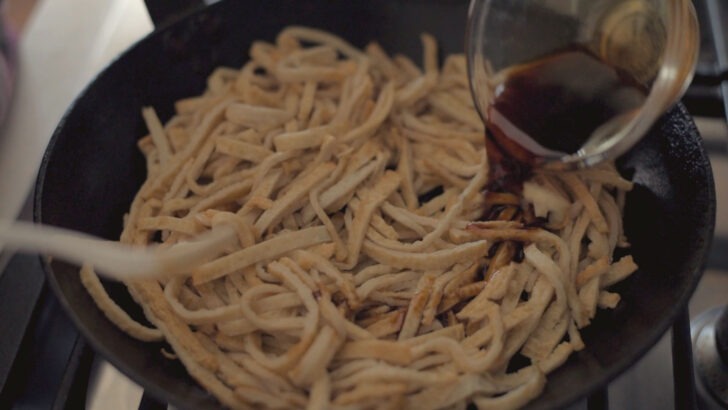
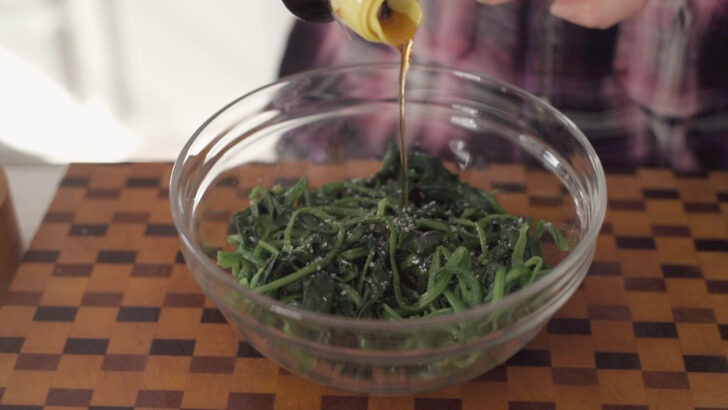
Prepare fillings: In Korean home cooking, each filling is cooked or seasoned separately — carrots are lightly sautéed, spinach gets sesame oil and salt, fish cake has its own soy glaze. This way, every bite of kimbap has layers of flavor instead of bland vegetables tucked into rice. Once the fillings are prepped and ready, the rolling itself feels much easier.
How to Roll Kimbap
Rolling may take a little practice, but once you get the rhythm, it’s surprisingly fun! It’s easier to use a bamboo mat when starting out, though experts can roll without one.
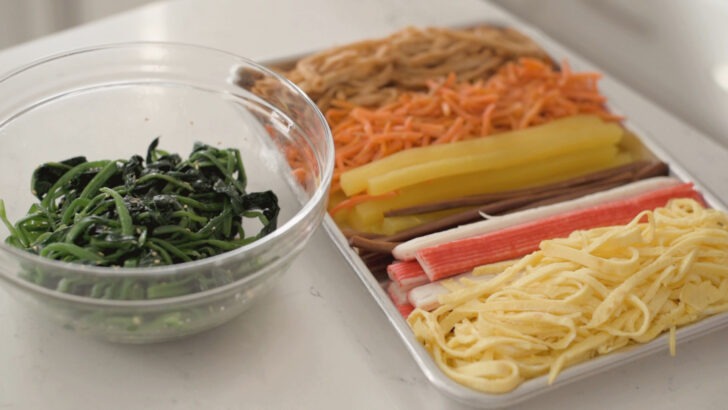
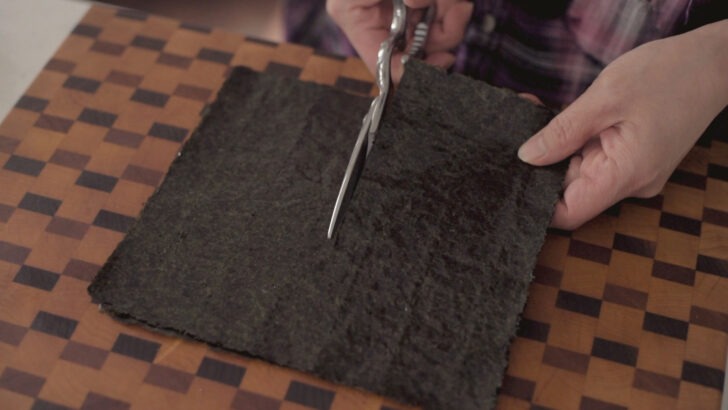
Organize your workstation: Line everything up within arm’s reach before you roll. Cut 3 full-size seaweed sheets in half to make 6 rolls.
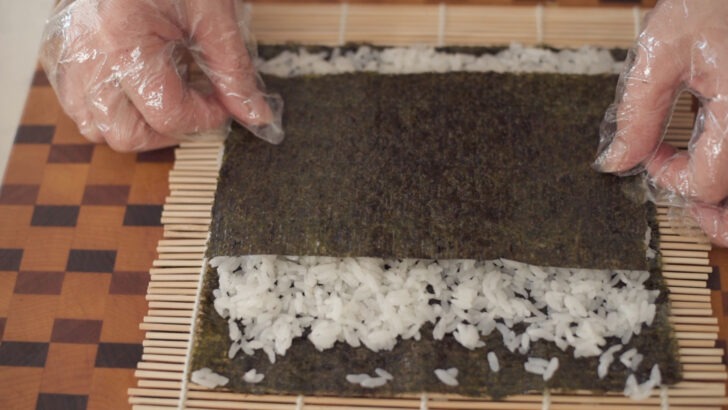
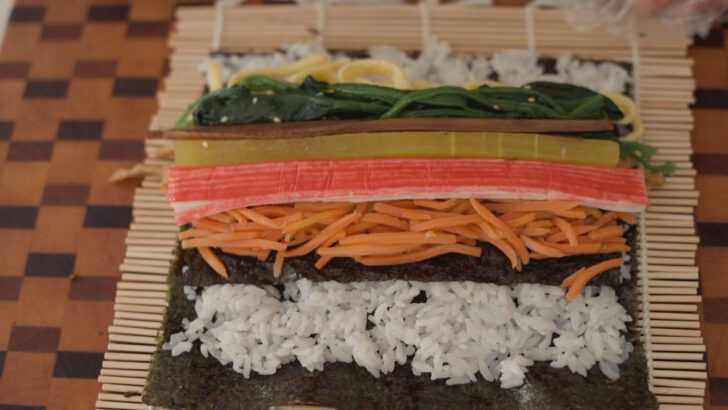
Spread rice and arrange fillings: Lay a full sheet of seaweed (shiny side down) on a bamboo mat and spread a thin, even layer of rice, leaving a small border at the top. I like to place a half sheet of seaweed over the rice before adding fillings — it’s a little trick I picked up after rolling hundreds of kimbap.
The second layer creates a neat border that defines the line between rice and fillings, giving the slices a professional look. It also helps keep any moisture from spinach or pickled radish from seeping into the rice, so the rolls stay firm and clean even after sitting in a lunchbox.
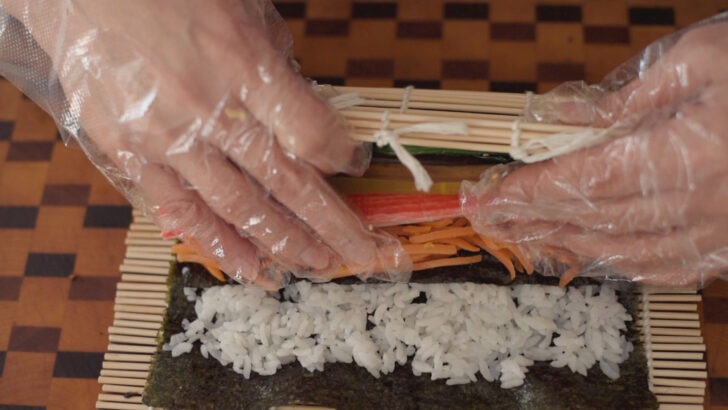
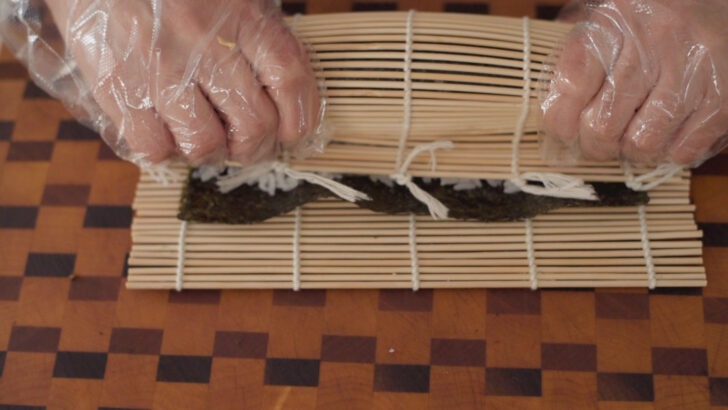
Roll it up: I gently tuck the fillings in with my fingers while rolling forward, applying even pressure but never smashing the rice. This keeps the roll tight in the center without squishing the texture flat. It’s a rhythm that feels awkward the first few times, but once you get it, rolling becomes fast and fun.
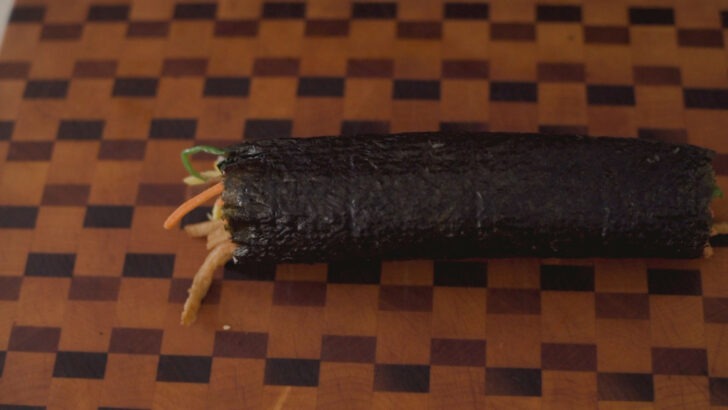
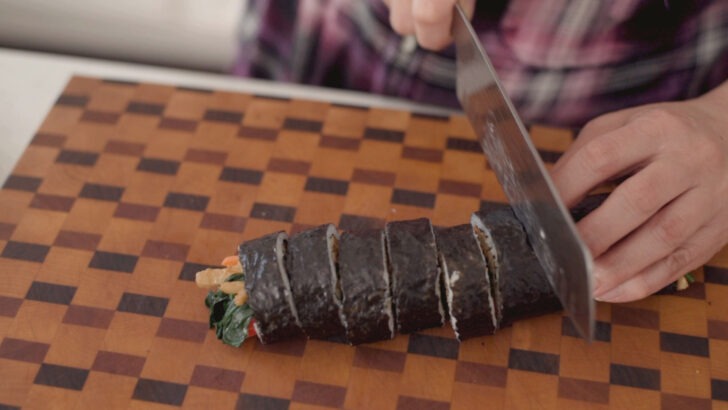
Slice cleanly: A sharp knife is non-negotiable. My mom always dipped hers in sesame oil, but I prefer wiping the blade with neutral oil on a paper towel. It keeps the seaweed from tearing and the slices neat — which makes the kimbap just as pretty as it is delicious.
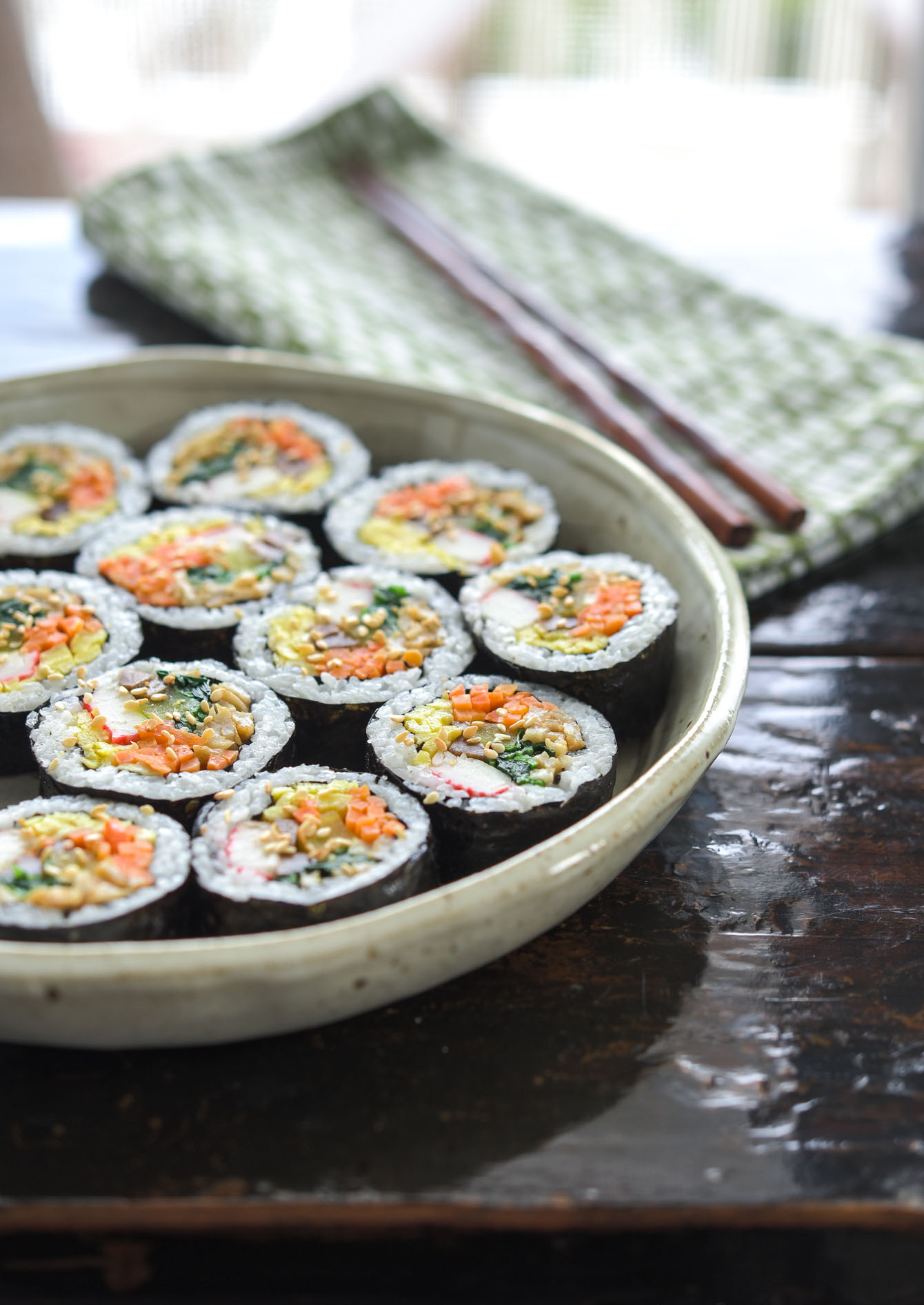
Storing and Serving Tips
Kimbap tastes best the day it’s made — nothing beats the texture of a freshly rolled slice. But if you need to pack it ahead, here’s what’s worked for me:
- For lunchboxes: I wrap each roll in parchment paper or foil. This keeps the rice from drying and makes it easier to cut on-site if needed.
- For freezing: Wrap individual pieces in plastic wrap, then freeze in a single layer. They won’t be quite the same once thawed, but the flavor holds up surprisingly well. I often do this when I have leftover rolls, and they make a quick snack later.
- For neat presentation: Many Koreans like to brush the finished roll with sesame oil and sprinkle sesame seeds before slicing. It gives the kimbap a glossy sheen and a nutty aroma that’s very traditional. Personally, I skip this step for my classic kimbap because I prefer the cleaner taste of the fillings without the sesame oil overpowering them — but this part really comes down to personal preference.
Watch Recipe Video
Love this recipe? Rate it and share your experience in the comments below! On Instagram? Tag me to showcase your creation. For more delicious recipes, subscribe to our newsletter!
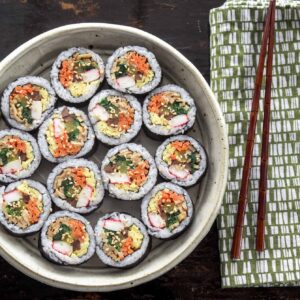
Kimbap (Gimabp) – Korean Seaweed Rice Rolls
Recipe Video
Ingredients
For the rice
- 2 cups (480 ml, about 450 g) uncooked short grain white rice
- 2 1/2 cups (600 ml) water
- 2 tbsp (30 ml) Korean plum extract (maeshil cheong)
- 1/2 tsp salt
For the filling ingredients
- 6 strips pickled radish (danmuji), 1/2 inch thick, drained
- 6-12 strips braised burdock root (Oeong), drained
- 6 strips imitation crab meat
- 2 tbsp (30 ml) oil, divided
- 10 oz (283 g) package shredded carrot
- 2 tbsp (30 ml) water
- 4 eggs, beaten
For the fishcake
- 3 sheets flat fish cake, sliced thinly
- 1 tbsp (15 ml) soy sauce
- 1 tsp (4 g) sugar
- 1 tbsp (15 mk) sweet rice wine (mirim)
- 1 tbsp (15 ml) corn syrup
For the spinach
- 1 bunch (12 oz, 340 g) spinach
- 2 pinches salt
- 1 tsp (5 m) sesame oil
- dashes toasted sesame seeds
Equipment
Instructions
- For the rice: Rinse rice several times and drain. Soak rice in 2 1/2 cup water for 10 minutes. Cook rice until soft. Put hot rice in a large mixing bowl, add plum extract and salt; toss well. Cover rice with a kitchen towel and set aside to cool.
- For the egg: Beat eggs and cook in a skillet in 3 batches. Roll them up and slice thinly
- For the carrot: cook shredded carrot in a little oil over medium high heat with some salt. Add 2 tbsp of water to create a steam and cover with a lid. Cook for 2 minutes until crisp but tender.
- For the fishcake: slice fishcake sheets thinly and stir-fry in a little oil for 1 minute over medium high heat. Mix together soy sauce, sugar, and rice wine in a bowl, and add the mixture to the fishcake. Continue to stir-fry for another minute.
- For the spinach: blanch spinach in a pot of boiling water with some salt. Drain and rinse with cold water. Squeeze out the excess water. Place the spianch in a mixing bowl and season with salt, sesame oil, and sesame seeds. Toss well.
To assemble Kimbap
- Cut 3 sheets of seaweed in half and set aside.
- Place a full sheet of seaweed, shiny side down, longer side toward you, on a bamboo rolling mat. Spread about 1 cup of rice (1/6 amount) evenly on the seaweed leaving 1 inch of space at the end. Lay a half seaweed sheet in the middle of rice.
- Put filling ingredients on top of the half seaweed sheet in a contrasting color pattern.
- Lift the entire end of mat from your side with both hands, roll over to cover the fillings, tucking in the filling with your fingers. Put firm pressure on the roll and continue to roll again as you roll away the mat until it reaches to the end.
- Place the finished kimbap on a platter, seam side down, while you are making another. Cut kimbap into 1/2 inch thick slices with a sharp knife.
Notes
- If you want to season rice with sesame oil, toss rice with 1 tbsp sesame oil and 1/2 tsp salt.

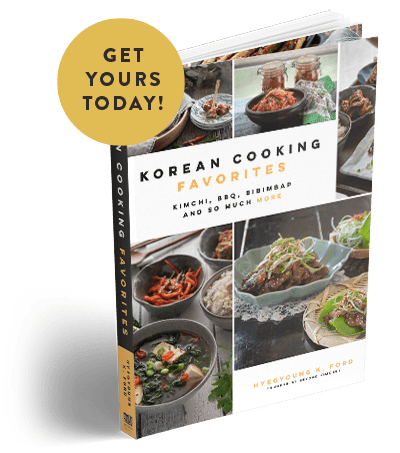
Is there a cultural significance behind the choice of ingredients in kimbap/gimbap, and how has the dish evolved over time to cater to different tastes and dietary preferences?
The cultural significance of kimbap lies in its portability and its sharable nature, making it perfect for enjoying with family and friends. It’s a popular picnic food, providing all the necessary nutrients in one convenient roll—rice, seaweed, vegetables, and often meat for a balanced and energizing meal.
Over time, kimbap has evolved to suit modern tastes and dietary preferences. You can now find vegetarian, vegan, gluten-free, and low-carb variations for health-conscious eaters. It also reflects global influences, incorporating ingredients like cheese, steak, tonkatsu, or avocado to appeal to a wider range of palates.
I only have one local Korean grocery store in my area and it’s tiny. 10 years ago they used to sell bulgogi kimbap for $5-6 per roll and it was a big roll, now it’s closer to $8-9 for the same thing due to inflation. That finally made me decide to want to make it at home.
I remember buying kimbap for $4.99 just a few years ago. I’ve heard the price has nearly doubled since then! That’s just so crazy!
Enjoy your homemade kimbap—nothing beats the taste of making it yourself.
Hi Holly! Thank you so much for the recipe. Under notes, for the optional vinegar mixture for the rice, is it 1/2 tsp or 1/2 TBS of salt?
Hi Lucy
It’s 1/2 teaspoon of salt. Thanks!
I would love to try making kimbap, but I have trouble eating seaweed. Is there an alternative to seaweed that I could use?
Hi Jo
You can roll with cooked egg sheets. Check out my kimbap video to see how I made the egg sheet. In that case, you can omit the egg in the filling. Hope this helps.
Thanks for the recipe.
These are fun — look great, and I’ll bet they taste great. Agree with Angie that they look like a professional sushi chef made them. 🙂
I wasn’t familiar with kimbap before this post, but the process seems very similar to making sushi at home. There was a time (pre-child) that Laura and I used to make sushi at home. We still have the rolling mats and stuff…and you’ve inspired me to pull them back out sometime soon. This sounds like a fun recipe to make together on a weekend evening!
It is indeed fun to make kimbap especially with families. Hope you can try making one. You don’t have to put all the filling ingredients and be creative to make your own style.
I’ve never heard or even tried kimbap, but these rolls sound wonderful (Even though I might not be familiar with some ingredients). I also must admit the rolls look splendid and so neatly done – even layers, tightly rolled up. You don’t often see this quality even at a restaurant, and for some homemade rolls is is simply impeccable work!
I know some of the Korean ingredients are not common in America. Kimbap is becoming popular among many American these days. It take some effort to get them ready to roll, but worth the try. It is a wonderful finger food.
These look like from a professional sushi chef 🙂
Thank you.
is it absolutely required to use rice vinegar?
You can use white vinegar instead.
I have all the ingredients, and I’m excited to get started, however, all I could find was prefried fish cakes, do I still prepare it as suggested? Or do I just reheat them? Thanks for your help.
Hi Michelle
You can prepare it with the recipe to add more flavor or you can use as is. Usually it tastes better if you add the seasoning to the fish cakes. Have fun making them. They will be delicious!
Thank you Ms.Holly for a visually beautiful guide on how to make a kimbap! I’m really thankful for your detailed instructions which is easy to follow. And I have just read your introduction in the ABOUT page, aw, it so sweet of you Ma’am, to create this blog as a gift for your children.. May God bless you more Madamme and your family ’cause you deserve it!
P.S. What camera did you use Ma’am? You’re pictures are all good. ^v^
Thank you so much for your blog! My husband is half Korean, and my mother-in-law has taught me to cook a lot of Korean food. Your recipes are authentic and delicious 🙂 My mother-in-law doesn’t have her recipes written down, and whenever I refer to this blog when I have a question, it turns out just like hers! YAY! Thank you! Do you have a recipe for kongnamul soup?
I posted Beef and Bean Sprout Soup yesterday. Hope you get to try it. There are may versions of Kongnamul soup. I will remember to post as much as I can.
Hello, Holly! I’ve been reading your various recipes as I prepare for a big Korean lunch tomorrow with guests! I’m trying your cola braised Korean chicken + my other usual panchans. 🙂 I’ve made kimpop from another recipe, and they were good, but something was not quite right. I never steamed my carrots (!!) and I never rinsed the radish (!!!) which may be the missing steps. Thank you for the details that help a non-Korean wanna be chef!
Question: is there a specific way to cut the kim-pop? I’ve tried using different knives, but have trouble with my seaweed tearing or the kim-pop tearing apart while I try to separate them. Am I not pressing the roll tight enough? Any input is appreciated!!!
Thanks from your Padawan Learner,
Jessica 🙂
Hi Jessica
Sharpen your knife before cutting. Avoid serrated knife. Instead of pushing down motion, use jigsaw motion to cut through the seaweed layer. Also try not to cut each slice too thin, at least 1/2″ thick slices unless you have a very sharp knife. I usually wipe my knife with a damp cloth (or wet paper towel) per each kimbap roll before you cut to remove the stickiness from the rice in the previous roll. Basically you wipe off the sticky residue from your knife every roll you cut.
Coat your kimbap roll with a little sesame oil or other oil by using your hand or brush, just to bring a little shine. It also help strengthen the seaweed.
Hope all these tip will help. Tearing happens sometimes but I like it because the torn piece can go into my mouth immediately. 🙂
I realy like your blog. This is the first time I see this blog. Yes, i like the way you show how to roll the kimbap. Thank you for sharing.
How to keep the rice rolls fresh if made them a day before?
Thanks.
You can’t. You need to consume on the day you made. They don’t keep well in the fridge.
Wow!! you my friend are just simply AMAZING!! I love the humor you bring to the table so to speak =) I just wanted to say that the recipe you have listed is the best one I have came across so far *and my search is done now since I found you* Thank-you for being so awesome!
How would the rice cooking change if I want to use brown short grain rice instead?
I made these for my family and they turned out great! Thank you for this recipe!
김밥에 김치하고 함께 먹어도 너~~~~~~~~무 맛있어요^^
캬! 맛있죠 그렇게 먹으면…
I love your recipe.. And i really enjoy your story.
Hi! I loved reading this post! Thank you! Great stories that made me laugh! I was inspired to make Kimbap.
I love how you called the Kimbap “Black Beauty.” It reminded me of some memories.
I’ll have to try making the pickled radish too.
Thanks Samantha. You did a great job with your kimbap.I enjoyed reading your post.
Our family loves making and eating kimbap! We play around with the fillings – sometimes adding different things like avocado, cucumber or kimchee. But I don’t like that there is saccharine in the pickled radish. The radish is really an essential flavor that is needed and the kimbap tastes bland without it. So my question: is there a way to make the pickled radish at home, so that I can keep the saccharine out?
Also – I loved your story about your childhood friend. Now everytime I make kimbap for my daughter’s lunch I hum Billy Jean to myself and smile!
Hi Linda
Yes, you can make pickled radish at home. Get a Korean or daikon radish and and slice into long strips (the size you desire for making kimbap). Sprinkle 1/4 cup of coarse salt per radish and let it soak for 1 hour. Drain the liquid that has been extracted from the radish.
In a pot combine 1 cup vinegar + 1/2 cup water + 1/4 cup sugar together and bring to a boil stirring to dissolve the salt. Remove from heat and pour over the radish. Let it sit in the room temperature for 4 hours, then keep in the fridge for 3-4 days and your radish will be ready to serve. Store them in the fridge for as long as you want.
It is nice that your family enjoy making Kimbap. It is a great family activity, isn’t it?
Delicious! Mine didn’t look like the picture, but they were still good.
I believe that taste is more important than the look when it comes to a food. Glad to hear you liked it. Thanks!
May I ask, why must we put kelp into the rice in water?
Hi, the rice seasoning in this kimbap recipe is closed to the Japanese sushi rice which my family often use. Sea kelp adds nice flavor. You can omit the kelp if you prefer without it.
Wow, this looks delicious. I must try it sometime soon. I love sushi of all forms and although there is no raw fish here, it looks delicious. I am not sure where I would find the fish cake, but I am sure I can substitute.
Yum I love whenever my mom makes this! Hopefully I can make it for myself now.
Yes. If you are doubling the amount of rice, you can double the vinegar seasoning mixture as well. You've must made them very well last time. They like to put you to work! Have fun making them!
Hi there! I made this recipe the other day and now I've been asked to repeat it again, but for double the people! Can you simply double the rice and vinegar portions? Or should it be to some other ratio? thanks!
Wow. Looks fabulous, I am going to give this a try.
Hi Lori
rice vinegar is the best option but if you can't find one, sub with sherry
wine vinegar or white vinegar. Use a little less amount since rice vinegar
is milder than the other kinds.
Hope you enjoy your stay in Egypt.
Holly
ohh, this brings me back to my days living in seoul! i miss kimbap! I have a question. I live in Cairo now, and their rice is short grain so I think it will be fine…IF I can't find (or afford at the expensive import stores) rice vinegar, what do I do???
Thanks!
@ce447ac57cc910942e49530e7174c48d:disqus
I don't use dipping sauce. It is just good to eat without it. However, I often make simple miso soup to go with though.
I'm so excited to try this recipe. It looks delicious and it's one of my favorite things! Is there a dipping sauce you usually make with it?
@9ddada242b78c88059a25a727b6c7e93:disqus
Hope you can make Kimbap soon. Yes, I agree that the surprise is doubled because it exceeds the expectation you had. Thanks.
@4bed61f208a84803d3710771a1019d05
Thanks Rowena.
Your kimbap looks so mouthwatering…! Everytime I a visit a blog and somebody makes kimbap or sushi, I always think, 'I need to make this tomorrow!' ;). The story of that old classmate of yours is so funny, but often quiet people have got surprising talents. And the surprise is often doubled, because they tend to be so introvert and quiet ;).
I like how you are so precise with your step-by-step food pics (never would have thought about cooking rice in a cast iron pot), but that memory about Mi-gyoung is too precious! You're not only a fantastic cook, but also a great storyteller.
kimbap always reminds me of being a kid. we always had it for road trips and picnics too, i really should make some!
Oh, this is bringing back so many lunchtime memories! I'm half-Korean and grew up in the States, and sometimes my mom would pack kimbap for my lunch, which I loved, except when some other kids teased me for my "weird" food!